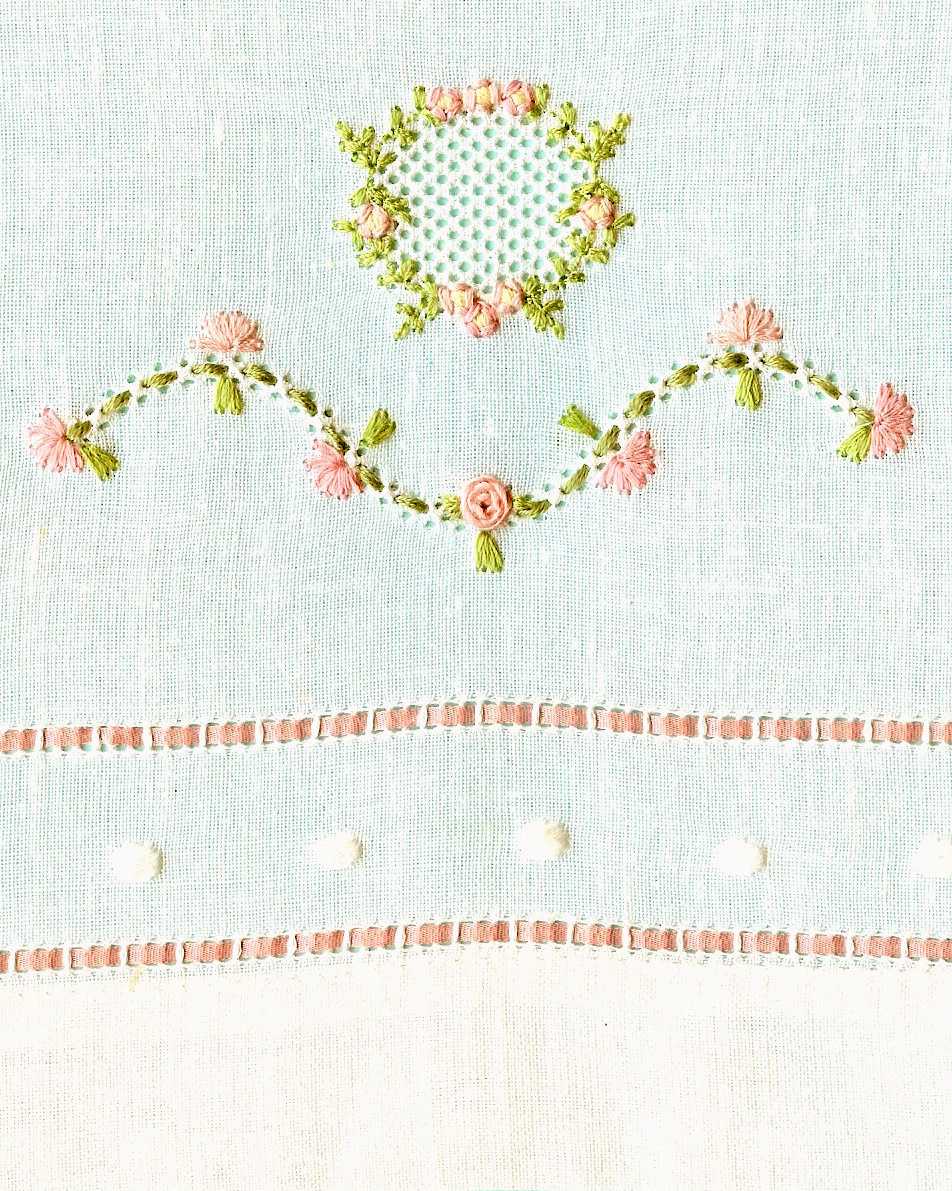
Blue paper has been placed behind the towel so the fil tire' would show up in the scan. The towel is white.
Or make pretty guest towels, like this one. Ralph is so on target as he observed that we all want to go the extra mile to make our house pleasant for guests. To that end, most readers and the writer of this blog  usually go the shorter and more pleasant mile to our sewing machines rather than driving to the grocery store to please our guests.
The linen towel in the photo was lovely even before the addition of machine embroidery. Threaded with silk ribbon, two rows of hemstitching border a row of classic padded satin stitch dots.   It was pristine.
Further embellished with Suzanne Sawko’s design, it is lovelier still.  The  hand-look fil tire’ oval is stitched with a wing needle and 80 wt. Madeira Cotona thread. The oval is surrounded by greenery and pinwheel roses hovering over an entredeux vine with more flowers.  Strands of the same green thread are woven through the entredeux stitches afterlazy daisy flowerettes have sprung from the vine.
These two designs, the fil tire’ wreath and the entredeux vine, are part of the Fil Tire’ and Fancywork Combinations embroidery design collection done by Suzanne Sawko and me.
I have taught this project in Huntsville, AL, at Martha Pullen’s School of Art Fashion as well as in Myrtle Beach, SC, San Juan, Puerto Rico and various other locations. Without exception, as students examine the sample before class, their first comment is an incredulous query about the apparent bullion rose at the center of the vine. Was this done on the embroidery machine?  The answer is both yes and no.
This is actually a web rose costumed as a bullion rose. If you click on the photo to enlarge it, you can see it more closely.  The “yes” part of the answer is that the spokes of the web rose are laid in place as part of the embroidery design. By hand, this step takes some time as it is hard space the spokes and make them equal in length. So the embroidery machine saves some time.
Without an embroidery machine, you can duplicate this web by dropping your feed dogs, setting your machine for a wide zig zag–it really should be at least 5 mm but 7 is better as this is the radius of the circular rose–and stitching zig to the right and zag to the left, into the same hole, the pivoting and placing the 3, 5 or 7 spokes. This will give you a web approximately the same size as the one shown. Fewer and shorter spokes will result in a smaller rose. Be sure to tie the spoke threads securely as there is a lot of stress on them as the rose is created. Floating a piece of Stitch N Ditch or water soluble stabilizer under the fabric will keep the zig zag from tunneling. Regular tearaway will pull the stitches loose when it is torn away.
The “no” part of the answer is that the actual fill of the web rose is done by hand, with a needle and 8-10 strands of the pink sewing thread, depending on the thread weight. The web rose is like a spider web and requires an odd number of spokes to work. After the web is placed, the threaded needle comes up almost at the center and weaves the threads over and under, over and under until the outer limits of the spokes are filled. By doing this, you will get a very nice looking web rose.
But if you take just a little more trouble, and practice, you can get the effect of the wrapped bullion stitches. For the first round or two, you just weave. Then the 8-12 strands of thread are twisted tightly at the end near the last “under” spoke that the threads ducked under. With your fingernail, you hold the loops in place, lying them over the next  “over” spoke as you slip the needle  under the next “under” spoke. This creates a faux bullion knot. The spoke under which the needle just ducked holds those loops in place.
You continue around the web in this manner until the web is filled and the spokes will not bear the burden of another faux bullion knot. Be sure to end with an under spoke and then slip the needle to the back of the fabric and knot off.
There will be a bit of a hole at the center from which the spokes radiate. I usually put a French knot or 3 to fill the space.
For those who are very proficient at bullion roses, it is probably faster to do one in the conventional manner. I can do an acceptable rose, but for me this is much faster. For those with arthritis or other limitations, certainly the untwisted version would surely be easier and very attractive. For others, for whatever reason, this faux bullion can be very useful.
With the hand worked hemstitching, padded satin stitch dots and the cotton machine embroidery threads, the viewer is easily led to believe that it is done completely by hand. A good part of that illusion is created by the cotton thread used–the Mettler 30 wt. and Madeira’s 80 wt. Cotona. Additionally, the design’s faithfulness to replicating hand stitches furthers the deception.
If any readers would like this useful web rose design file, just leave your request in the comments section. I’d be happy to share it with you.
I know the towel is useful. It now hangs in my guest bathroom, in anticipation of tomorrow’s arrival of a beloved friend from my youth. During our freshman year in college, Janice Kay lived in the room next door. She was the first person I had ever met with the same name as mine. We used her first and middle name to differentiate from me, just Janice. But we share more than the same first name–values, love of animals and more. I taught Janice Kay and every one of the other 48 girls on our floor to knit a pair of slippers. To this day, she knits baby caps for third world countries.
As Ralph said above, I will not rely on wit to make my house pleasant. But I am sure that shared memories of a 46 year old friendship, this guest towel and  a tub of ice cream will do the trick.

